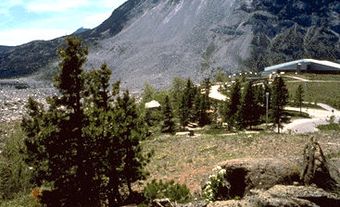Volcano
A volcano is an opening in the crust of a planetary body through which liquid, gaseous or solid material is expelled; also the structure formed by eruption of this material. Most terrestrial volcanoes expel magma, a mixture of molten rock and dissolved gases (eg, water vapour, carbon dioxide, sulphur dioxide). The Earth's volcanic belts are located above zones of anomalously high temperature (700-1400°C) where magma is produced by partial melting of solid material in the crust and upper mantle. These areas commonly occur along crustal plate margins at depths of 10-50 km (see plate tectonics). Basalt is the principal magma of diverging plate boundaries such as the oceanic spreading ridges; basalt, andesite, dacite and rhyolite characterize volcanic arcs along converging plate margins. The relatively low density of magma causes it to rise through fractures into regions of lower pressure where dissolved gases expand and propel it toward the surface. Magma trapped in shallow reservoirs may solidify to form subvolcanic intrusions or may undergo chemical change before resuming its ascent. Evacuation of such reservoirs sometimes causes overlying rocks to collapse, leaving steep-walled, circular depressions (calderas). Groundwater heated by magma may discharge as hot mineral springs, as geysers or as fumaroles, or steam may escape in explosive bursts (phreatic eruptions) which commonly precede eruptions of magma. Magma reaching the surface may issue as molten lava or as solid, pyroclastic ejecta (bombs, blocks, lapilli, ash).
Eruptive behaviour depends on the magma's temperature, composition and gas content, and on whether the vent is on land (subaerial), under water (subaqueous) or beneath ice (subglacial). Subaerial eruptions of characteristically fluid basalt are usually accompanied by fire fountains of incandescent globules thrown out of the vent by expanding gas. The globules fall back around the vent, building a pyroclastic cone, but most of the magma spreads in the form of thin lava flows which may build broad shields or lava plateaus. Escape of gases is restricted in viscous andesite, dacite and rhyolite magma. The trapped gases may inflate the melt into a porous froth (pumice) or may escape explosively, tearing apart the stiff, enclosing magma and hurling ash and pumice fragments from the vent.
In these Plinian eruptions (named for the Roman scholar Pliny the Younger, who witnessed the event), columns of hot gases carry plumes of fine ash high into the atmosphere to be spread for hundreds of kilometres. Dense mixtures of hot gases, ash and pumice sometimes form fluidized flows (eg, ash flows, pyroclastic flows, glowing avalanches) which sweep rapidly down the flanks of an erupting volcano. Lava associated with such eruptions is commonly so viscous that it clings to the slopes in short, thick flows. These alternate with pyroclastic deposits to form steep-sided, composite cones with the classical symmetry of Mount Fuji. Extremely viscous lava, containing little gas, may pile up over its vent into bulbous lava domes or may project from the vent as crumbling spines of incandescent, nearly solid rock. Lava that enters water from a subaqueous vent is quenched, resulting in a glassy rind that may fracture into a pile of fragments or act as a viscous skin enclosing molten lava.
In shallow water, magma thrown from a subaqueous vent by expanding gas is quenched to solid ejecta which accumulates as a tuff ring. In contrast, lava from vents on the deep ocean floor issues quietly, its dissolved gas held in solution by enormous hydrostatic pressure. Ejecta from subglacial vents may accumulate on the ice as supraglacial cones which collapse when the ice melts. Alternatively, lava may thaw a hole in the ice and there accumulate to form a steep-sided, flat-topped table mountain (tuya).
The deeply eroded remnants of ancient volcanic belts are found in volcanically inactive regions such as the Canadian Shield. In Canada, geologically young volcanoes are confined to the Western Cordillera. The Garibaldi belt of southwestern BC includes many supraglacial and sub-glacial volcanoes. Lava plateaus and shield volcanoes dotted with pyroclastic cones cover much of central BC; and composite volcanoes, such as Mount Edziza, form a belt extending from northern BC into the southern Yukon Territories. No historical record of an eruption in Canada exists, but native legends and radiometric dating suggest that the Aiyansh lava flow near Terrace, BC, was extruded about 200 years ago. The explosive eruption in 1980 of Mount St Helens, Washington, left nearly 400 km2 of total devastation.
Eruption forecasting, based on the detection of precursor events such as seismic activity, tilting and heating of ground and emission of gases, may soon provide a warning to people living in areas threatened by an impending eruption. Volcanoes are not unique to the Earth. The dark maria of the moon are lava plains formed by the eruption of basalt. Olympus Mons, a Martian shield volcano 700 km across and 27 km high, is the largest volcano in the solar system. Io, an inner moon of Jupiter, is the most volcanically active body yet identified in the solar system. Its numerous volcanoes produce a dark lava (probably basalt) and a lighter material believed to be molten sulphur.
See also Geological Regions; Geothermal Energy.

 Share on Facebook
Share on Facebook Share on X
Share on X Share by Email
Share by Email Share on Google Classroom
Share on Google Classroom





